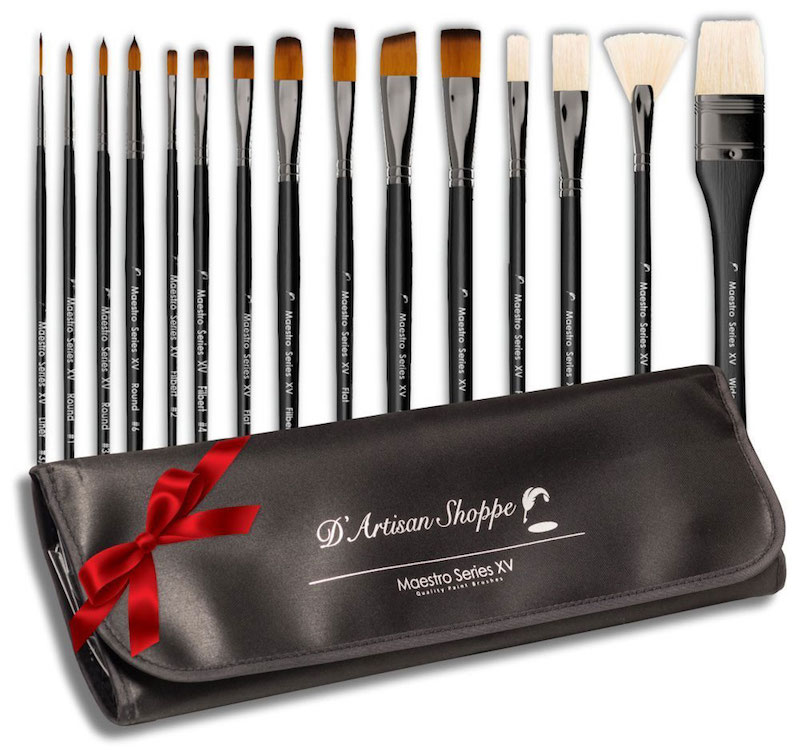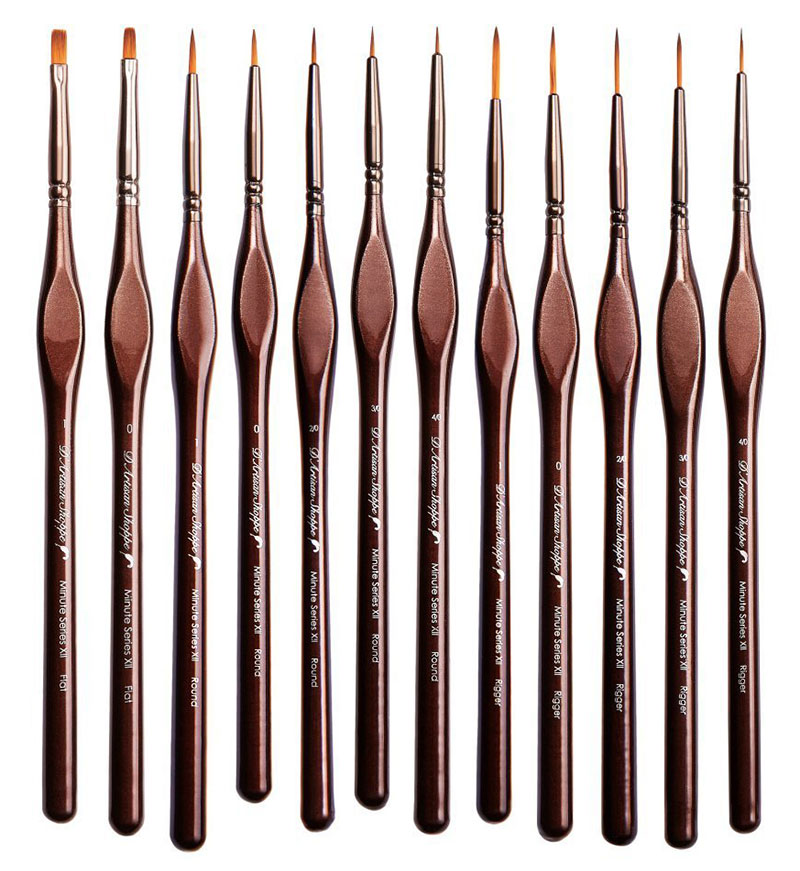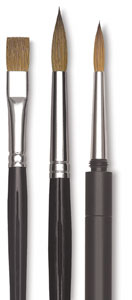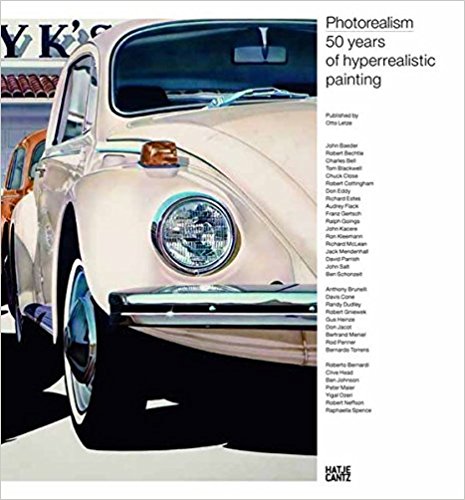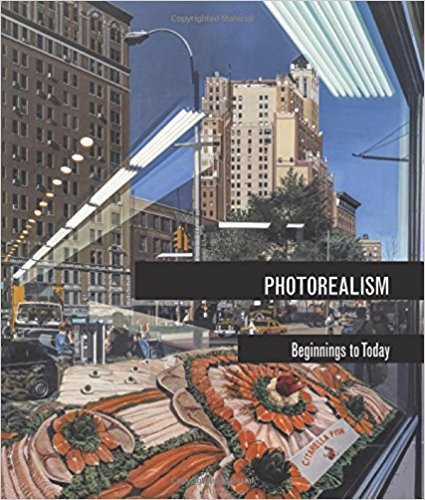Paintbrushes for Photorealism
This is Page 3 of a 15-page guide explaining how to paint photorealistically.
On this page we'll discuss paintbrushes for photorealistic painting.
Paintbrushes are the tools you will use to create your magic upon the canvas. Below, you can see 7 brushes that I use when making small photorealist paintings (6" x 6" or 5" x 7"). On the brush handles, you can read the brush size, type, and brand. If you're planning to do small photorealist paintings, you can get an idea of the size and type of paintbrushes you'll need by taking note of these!

The brush types that I use are liner, round, filbert, and flat (also called "shader").You can learn more about the different types of paintbrushes and what they are used for in my Artist Paintbrush Guide. For each brush shape, I generally have at least 2 different sizes at my disposal. Depending on the size of your painting, you may want more sizes.
It is recommended that you use synthetic paintbrushes for use with acrylics, rather than brushes with natural hairs. I think it's important to first buy paintbrushes in person, as opposed to online, so that you can examine the brushes up close and compare them. Later, once you've used different paintbrushes and fallen in love with certain ones, you will know which ones to get if you want to buy your art supplies online.
When purchasing a brush, go to the section of the paintbrushes that are labeled for use with Acrylics. Look for the sizes and shapes that seem most appealing to you. The size of the brushes you'll need depends on what size your painting will be, but no matter how large it is, you will always need a good range of small and tiny brushes to do all the tiny details involved in photorealism.
You'll want to choose paintbrushes that are good quality, but that doesn't mean they have to be expensive. I'll share with you my brush secret: I've happily used "affordable" brushes for my entire career. I used to use Loew-Cornell Paintbrushes until that brand was discontinued. Now, I use this Maestro Series XV Paintbrush Set (affiliate link), which has a good selection of brushes that are suitable for most paintings. If I'm doing a small photorealist painting with lots of tiny details, I use brushes from this Minute Series XII Paintbrush Set (affiliate link). Both of these sets are excellent value, whether you're a beginner or an experienced artist.
Paintbrushes, especially tiny ones used for extremely detailed work, do have a limited life span. As soon as the hairs start to become a little frayed, they are no longer suitable for the detailed work of photorealism, because they can't contain or handle the paint correctly. I never throw them away though - when they reach this stage, I just use them for my abstract painting, where precision is less important! I've found that cheaper brushes don't fray that much faster than the expesnive ones, especially if you take care of them.
So when you're in the art supply store looking for the perfect brushes, remember that they are not all created alike. Some are cheap quality, some are good quality; some have soft bristles, some have harder bristles; sometimes have flexible bristles and some have stiff bristles. I always feel the hairs with my fingers to get a sense of its softness and how easily it bends. I look for hairs that are nice and soft but not too bendy. Bristles that are too bendy mean that when loaded with paint, the bristles will flop around and be hard to control. Also, you will need a tiny brush or two, but you probably won't need to get brushes that are too mega-tiny (meaning the ones with just a few teensy-weensy hairs sticking out). They can be hard to control as well. I tried them when I first started painting photorealistically, and could never get them to do what I wanted them to do. So if you need to do mega-tiny details, I would suggest just using a tiny amount of thin paint on the very tip of a tiny brush.
Aside from the background, I typically use just one, very tiny brush for the majority of the painting. On the nearby image (of the chocolate bunny) you can see the size of the brush as compared to the size of the painting. To give you an idea of scale, the width of the bunny's ears from left to right is about 1.5 inches, not including the shadow. Using a tiny brush allows for excellent precision and control.
Read my Artist Paintbrush Guide to learn more about the different types of paintbrushes and what they are used for. You will also find information about how to properly care for, clean, store and transport your paint brushes, so that they last you a long time!
Paintbrush Sets
The products below are available on Amazon. As an Amazon Associate I earn from qualifying purchases.
I can also recommend a couple of paintbrush sets, which gives you the added benefit of acquiring all your paintbrushes at once. The Maestro Series XV Paintbrush Set includes 15 paintbrushes of various sizes and shapes, such as round, filbert, flat, angle, etc. 11 of the brushes are synthetic and 4 are natural hog hair brushes. The Minute Series XII Paintbrush Set includes 12 synthetic brushes designed for painting in small details, which is especially handy when it comes to painting photorealistically. The Minute Series includes pointed rounds, flats and liners. I've used both of these sets with acrylics, gouache and watercolors and found them to be great quality brushes at an affordable price.
I've provided links below to the relevant products so that you can easily find them on Blick Art Materials, my favorite online art supplier. I'm a member of Blick's affiliate program, which means if you make a purchase after clicking on one of these links, I'll receive a small commission (at no extra cost to you). See my Disclosure Statement for more info.
Da Vinci Maestro Kolinsky Brushes
If you've like to try some more expensive, artist-grade brushes, check out Da Vinci's "Maestro" series. These brushes are manufactured using male winter Siberian Kolinsky Red Sable fur. These are top-of-the-line, high quality brushes.
The extra sharp needle-like point and longer tapered hair length result in faster action at the tip and the tightest snap at the point. Expect superior spring and control, plus unsurpassed water-carrying performance. All brushes have plated brass, seamless ferrules.
Read More
Read a current and historical overview of Photorealist painting techniques and methods. It is beneficial to familarize yourself with this information before you embark on your own journey to create photorealistic paintings.
Familiarize yourself with the Photorealist art movement by reading my overview of Photorealism.
The books below are available on Amazon. As an Amazon Associate I earn from qualifying purchases.


